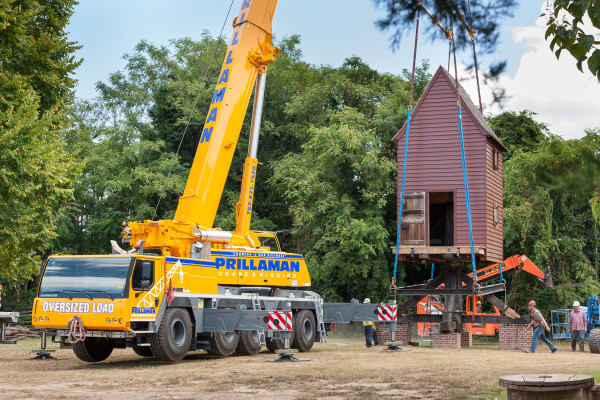
I asked Matt Webster, Director of Architectural Preservation, if it was possible that anything could go wrong. “Oh, lots,” he said. We were among the dozens of onlookers who came to witness the two big pieces of the old windmill being put back together after being refurbished.
The mill house, weighing in at 28-thousand pounds, had to be dropped neatly onto the 18-foot tall king post. Like horseshoes, except instead of your hand, it’s a 180-ton crane doing the work.
And it goes a lot slower.
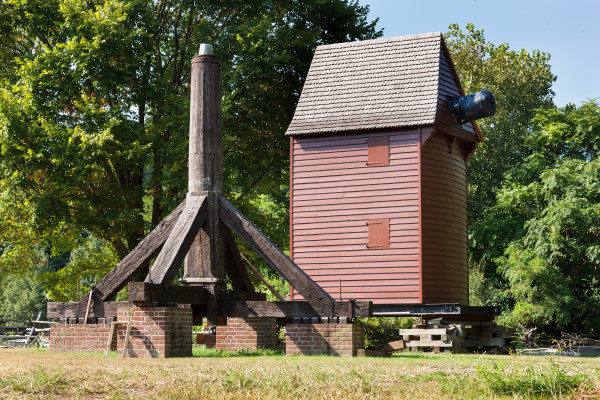
The five-man crew arrived just after 10 a.m., a late start necessitated by the special permit required for the lumbering, 10-wheel drive crane to use the highway. They got to work quickly, fastening a square of steel beams that would support the house as it was hoisted high into the air before being lowered onto the king post.
The most painstaking part of the process was balancing the house precisely enough that it would land squarely on its target. Minute adjustments were made repeatedly to the lengths of chain descending from the crane’s winch.
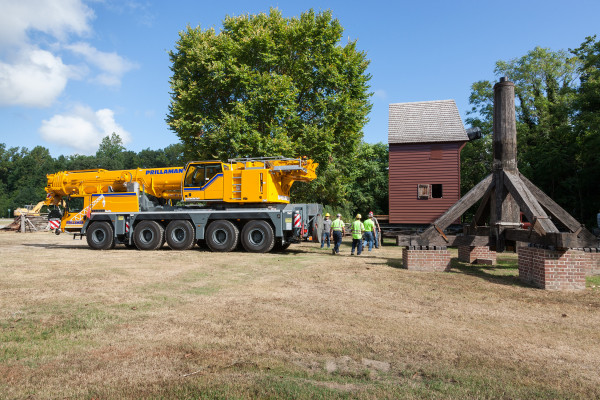
Finally the house was airborne, and after a few more minutes in its slow-motion arc, it landed perfectly. A member of the crew crawled into the house to guide it the final few yards.
For more than a year, a team of specialists has been working on refurbishing the windmill. First they dismantled it piece by piece. Then they made structural repairs, some period-appropriate additions, and added blocking to make future fixes easier. One key modification was the addition of “side girts,” side supports that ensure that the mill stays perfectly straight.
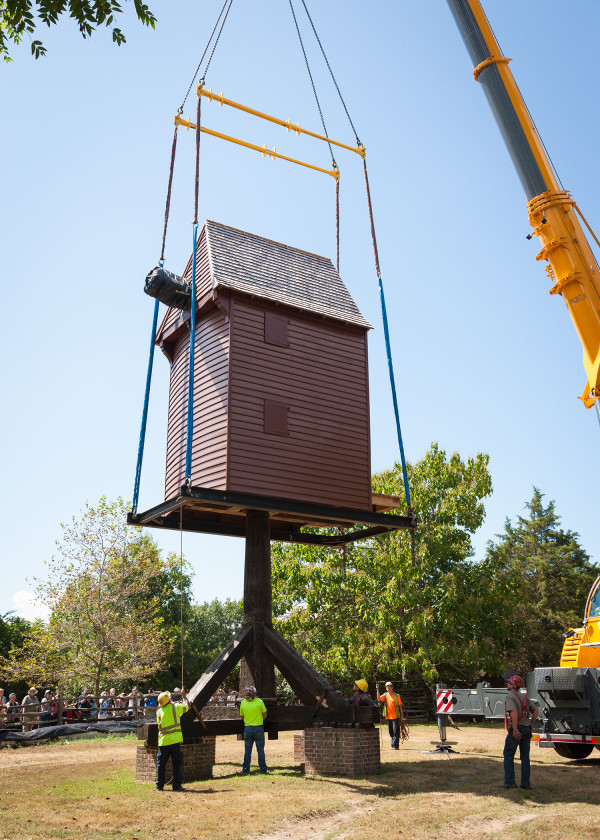
“Balance in the mill is really important,” said Matt. “You need those two millstones to sit flush against each other, but if you’re head sick (leaning forward) or tail sick (leaning backward), your stones are going to tilt and you’re not going to get that nice grinding surface, so you’re losing efficiency.”
Only a few more steps remain before the windmill retakes its iconic place in the colonial town’s landscape. In the next month or so, its sails will be put back in place. A stand of trees will be cut down to make actually catching some wind a little easier.
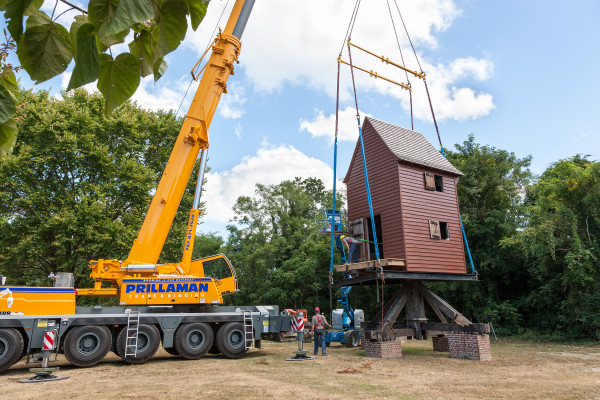
The tree removal will also offer guests coming into town from the bridge at the back of the Visitor Center a new iconic view as soon as they walk out the door and toward Great Hopes.
So which direction will the windmill face?
Trick question! Any way it likes. The whole mill can be turned in any direction to get the most favorable wind. That, Matt tells me, is called “winding the windmill.”
Long known as Robertson’s Windmill, the building was constructed in time for the 350th anniversary of the establishment Jamestown in 1957. It was built to the specifications of an 18th-century English windmill that still stands: the Bourn Mill in Cambridgeshire, England, built in 1636.
For half a century it stood at the Peyton Randolph House near the center of town (as seen below). But it hasn’t been open to the public since 2003, and it moved from the Randolph House to Great Hopes in 2010.
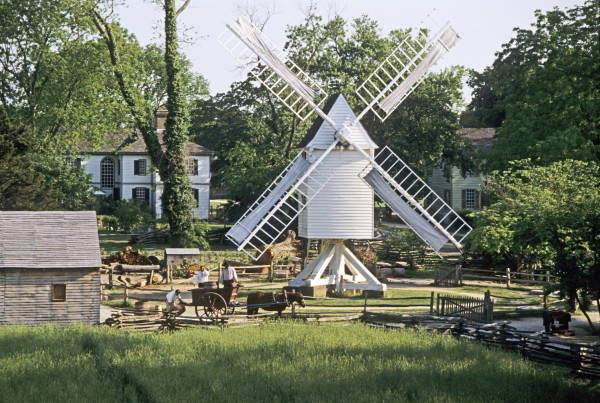
The move to Great Hopes Plantation reinforces the site’s emerging purpose as a typical middling plantation in colonial Virginia where they do real farming. It is a reminder that Williamsburg’s urban setting was the exception in 1776. And as important as the city was to the Revolution, it was an exceptional place. The farm represented everyday life for most people.
 There were many windmills in the area in the 18th century. One was close enough to town, just south of the Public Hospital, that it was pictured on the Frenchman’s Map of 1782.
There were many windmills in the area in the 18th century. One was close enough to town, just south of the Public Hospital, that it was pictured on the Frenchman’s Map of 1782.
Not so today. In fact, when the sails turn again, and the stones grind once more, the windmill at Great Hopes Plantation will be the only operational 18th century post mill in the United States.
“The mill really shows the industry and the ingenuity of the period,” said Matt. “It’s a way to see how things are produced and what technologies are available, how innovative people were in the 18th century. It wasn’t a simplistic world. It’s actually quite complex from an industrial standpoint.”

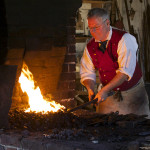

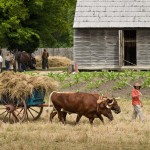
I’ve always been fascinated with windmills and have visited several on Cape Cod as well as the post mill that is referred to in your story, but then it was at the Randolph House. Tne Spocot post windmill in Dorchester County, MD is operational, and will next be demonstrated on October 17, 2015, here is their address: http://spocottwindmill.org/
Very cool. I didn’t know there was a windmill there. Outwardly, it looks a lot like the one here. Your comment also made me realize I inadvertently described the Williamsburg windmill as the only operational one, when I should have said only 18th century one in operation. I’ve updated the post to correct that. Thank you.
Have missed the windmill. It’s wonderful that it returns to operation…but how would it have been built originally?
Sandy, Matt Webster kindly took the time to offer a more expert answer than I could:
Thank you for your question. Originally it would have been built starting with the base. Once that was complete the king post (the large upright central post) would have received the crown tree, which is centered horizontally on the top of the king post. This is the pivot point for the mill body as well as the element the entire mill house hangs from.
During our lift, that was the trickiest part, making sure that those two elements matched up and fit properly. They did have lifting devices in the 18th century, block and tackle, A frames, and derricks to lift the heavier elements and hold them in place while they were being attached.
In the 18th century, these apparatus would have lifted elements like the crown tree, weighing around 1,000 pounds, and the wind shaft, which approaches one ton. These however would not lift the 28,000 pound mill body. Repairs in the 18th century would have dealt with the issues while the mill was still on its king post. We changed the method because it was safer to have the two elements separated while doing the work.
-Matt Webster